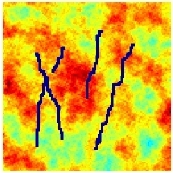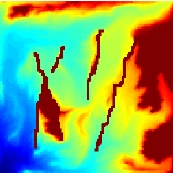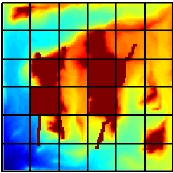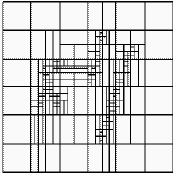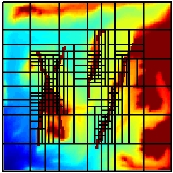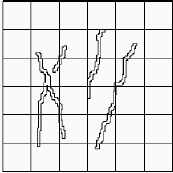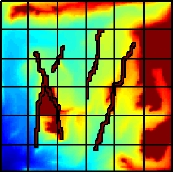GeoScale - Direct Reservoir Simulation on Geocellular Models
|
Hierachical Multiscale Methods on Nonuniform Grids
Earlier work has hown that the multiscale method performs excellent on highly heterogeneous cases using uniform coarse grids. To improve the accuracy of the multiscale solution even further, we have introduce adaptive strategies for the coarse grids, based on either local hierarchical refinement or on adapting the coarse grid more directly to large-scale permeability structures of arbitrary shape. The resulting method is very flexible with respect to the size and the geometry of coarse-grid cells, meaning that grid refinement/adaptation can be performed in a straightforward manner
Use Grid Adaptivity to Increase AccuracyConsider a quarter-five spot simulation defined over a heterogeneous permeablility field containing a set of barriers (with permability equal 1e-8 relative to the mean of the background permeability field). This example has been tailor-made to cause difficulties for the multiscale method. To solve the flow problem, we employ the multiscale mixed finite-element method on a 6 x 6 coarse grid. Several of the grid cells are cut into two noncommunicating parts by the barriers. In the figure below, we see that the method fails to flood the corresponding cells properly. The reason is the following: when generating the multiscale basis functions, unit flow is forced through each cell. Therefore the velocity basis functions will model an unphysically high flow, for cells that are cut in two halves by a traversing barrier. As a result, the contribution from each such basis function becomes very small in the solution of the global flow problem on the coarse grid and the flux into the cell is zeroed out.
Improved accuracy can be obtained by the following two approaches:
In the figure below we see that both approaches are able to reproduce the saturation with high accuracy. The best accuracy is obtained by adding barriers as coarse cells, even though this gives much fewer coarse cells than for the hierarchical approach. If the barriers are removed, all three grids above give the same accuracy, indicating that the choice of coarse grid has little influence for a smoothly varying permeability field.
General Unstructured Coarse Grids in 3DThe two approaches introduced above can easily be extended to three spatial dimensions. In the figure below, we consider a 30 x 80 x 10 subsample of the Tarbert formation from the second SPE10 model, in which we have introduced a few low-permeable walls (1e-8 mD). To improve the accuracy of the multiscale solution, we can either perform a hierarchical refinement or search for connected cells of very low permeability and add them as extra coarse cells to a uniform background grid.
Multiscale Methods - Great Flexibility in GriddingThe examples above indicate the great flexibility inherent in the multiscale method: each coarse grid cell can be defined (almost) arbitarily as a connected set of fine-grid cells. For permeability fields with relatively smooth variation (but possibly with large variations), the multiscale method is not very sensitive to the shape and size of the cells in the coarse grid. For nonsmooth permeabilities, on the other hand, higher accuracy is obtained by a careful choice of the coarse grid. References
|
||||||||||||
